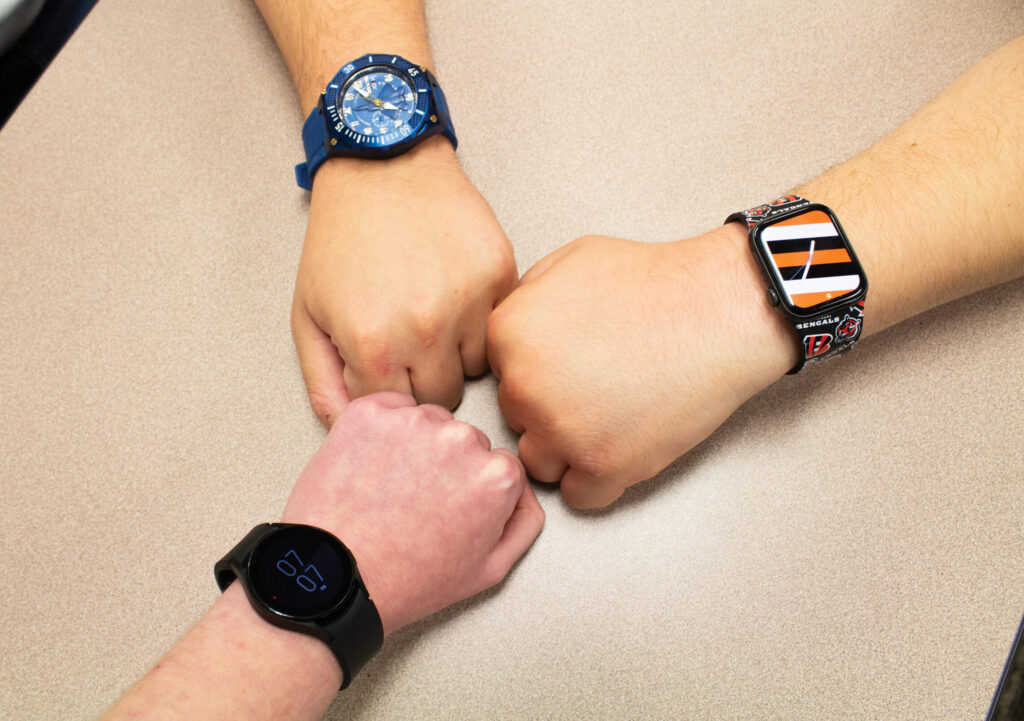In today’s fast-paced, tech-driven world, one accessory on students’ wrists has become a symbol of the times—quite literally.
Watches, once solely a tool for keeping track of time, have evolved into fashion statements and multi-functional gadgets. The debate between the classic analog watch and the modern smartwatch is heating up, with students weighing in on whether functionality or fashion should take precedence. On our campus, opinions vary widely, but one thing is clear: choosing smartwatches and analog watches speaks volumes about personal identity, priorities and style.
The rise of smartwatches over the past decade has undoubtedly shifted how people interact with their devices. From Apple to Samsung, smartwatches have transformed wrists into hubs of connectivity, health monitoring and even entertainment. Yet, despite their high-tech appeal, many still hold a special place for traditional analog watches, which are viewed as timeless, elegant and imbued with personal meaning.

Television and digital media production sophomore Tomas Rodrigues fell squarely on the side of analog watches, appreciating their simplicity and classic appeal.
“Analog watches are fashionable and serve the regular function of a watch,” Rodrigues said.
For Rodrigues, the analog watch doesn’t need bells and whistles, it’s the enduring style that counts. However, he doesn’t dismiss the benefits of smartwatches entirely, as he recognizes their utility in fitness tracking and health monitoring.
“Smartwatches are good for exercise, but people aren’t wearing smartwatches just for these functions. People wear them to fit in,” Rodrigues said. The appeal of smartwatches goes beyond mere functionality, touching on the social aspect of owning a piece of wearable tech that has become a status symbol.
The idea that smartwatches might be more about social conformity than necessity is echoed by other students.
Digital animation and game design freshman Michael Turner offers a more pragmatic take on the smartwatch.
“Smartwatches serve the same purpose as a phone, just on your wrist,” Turner said. “Analog watches serve only the purpose of telling time, and they complete this purpose.”
Many students see the smartwatch as an extension of their smartphone, providing immediate access to notifications, emails, and apps without needing to pull out their phones. However, Turner notes that this level of functionality comes at a cost—namely, the lack of character in smartwatches compared to their analog counterparts.
While it may seem like a limitation for Turner, this singular focus makes analog watches more appealing.
“Analog watches serve a sense of fashion, but smartwatches have no personality,” Turner said.
For many students, the decision to wear an analog or smartwatch isn’t purely about technology but what that choice says about them. Watches, especially analog ones, can carry deep personal meaning. They might be heirlooms passed down through generations or carefully selected pieces that reflect a sense of style and sophistication. For others, the practicality and versatility of a smartwatch can’t be ignored.
Nursing freshman Kenedy Hutchings brings a balanced perspective to the debate. As someone who values both fitness and fashion, she acknowledges the strengths of each type of watch.
“Smartwatches serve a purpose regarding exercise and fitness,” Hutchings said. “The ability to track heart rate, steps, sleep patterns and more makes smartwatches an invaluable tool for those looking to stay active and health-conscious.” However, Hutchings was quick to point out that smartwatches often fall short when it comes to fashion, highlighting how analog watches still hold a certain aesthetic appeal that digital devices struggle to match.
“They don’t compare to the style and fashion that analog watches have,” Hutchings said.
While Hutchings and others lean toward the idea that analog watches carry more fashion clout, some students see potential in the fashionability of smartwatches.
Information security and intelligence freshman Milan Black sees the customizable nature of smartwatches as a primary advantage.
“Smartwatches actually have some fashion ability with different color watch bands as well as different lock screens,” Black said.
The ability to change the look of a smartwatch to match her outfit or mood gives it a sense of versatility that analog watches can’t provide. However, she also values the emotional significance that analog watches can carry.
“Analog watches can have a history behind them, and they can also represent other things, such as family,” Black said.
This debate over watches reflects a larger conversation in fashion and technology: How do we balance the rapid pace of innovation with the desire for something lasting and meaningful? While smartwatches provide undeniable benefits in convenience, health monitoring, and connectivity, their short product cycles and emphasis on technology leave some yearning for the timeless elegance of analog watches.
Conversely, analog watches, while fashionable and often sentimental, lack the multi-functionality that many people have come to expect from their devices.
Ultimately, the decision between a smartwatch and an analog watch comes down to what matters most to the wearer. For some, it’s about practicality and staying connected in a world that never slows down. For others, it’s about making a personal style statement or holding onto a piece of the past. In the end, the choice of watch—whether digital or analog—continues to tick along with the beat of our ever-evolving lives.
